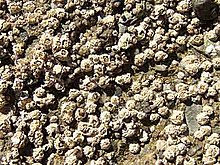| Balanidae | |
|---|---|
 | |
| Balanus glandula | |
| Scientific classification | |
| Domain: | Eukaryota |
| Kingdom: | Animalia |
| Phylum: | Arthropoda |
| Class: | Thecostraca |
| Subclass: | Cirripedia |
| Superorder: | Thoracicalcarea |
| (unranked): | Sessilia |
| Order: | Balanomorpha |
| Superfamily: | Balanoidea |
| Family: | Balanidae Leach, 1817 [1] |
The Balanidae is a family of barnacles of the order Balanomorpha. As a result of research published in 2021 by Chan et al., the members of the family Archaeobalanidae were merged with this family. [2] [3]